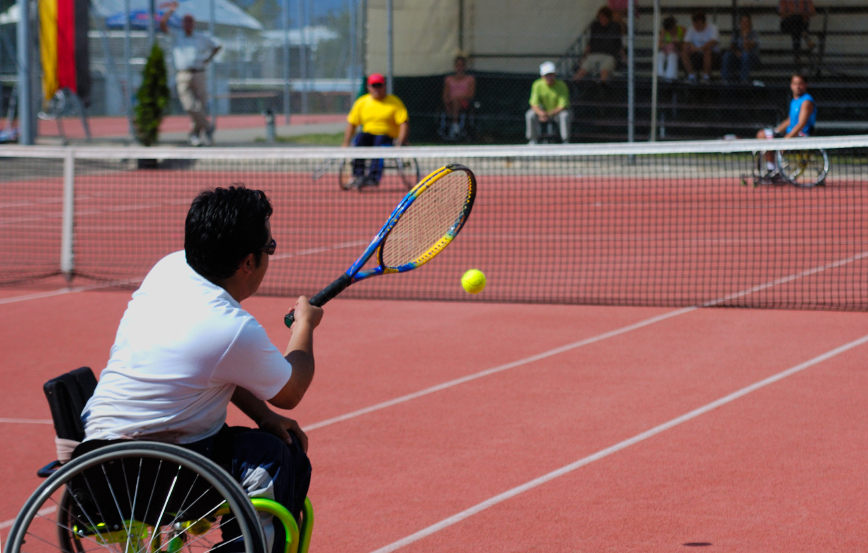Disability Access For Sports Construction
Inclusion and innovation: how to plan disability access in your new sport construction
Modern society now fully recognises the rightful place of disabled sportsmen in every sports arena from the tennis court to the rubber running track. With unprecedented UK investment in sport and widespread anticipation of the 2012 paralympics, every new sport construction must take proper account of accommodating disabled athletes – and indeed spectators – of all levels, whether you’re laying a new 3G pitch or designing a state of the art multi user games area.
Ensuring high quality disability access makes good sense for everyone, given that 20% of the UK population has some form of disability. Furthermore, the Disability Discrimination Act places specific requirements on you to ensure your sport construction does not in any way impede disabled people in enjoying their training. In 2010, the revised Equality Act defined new legal obligations to provide equal access where reasonable. That may be more complex in an old building, but managers of new sport constructions have no excuse not to provide the facilities that will give superb access to every user.
Inclusive access at every stage of your sport construction
There’s absolutely no point investing in a superb hockey pitch construction or a 21st century football pitch with floodlighting if half your potential players and spectators can’t use it – and if you fail to provide disability access your sport construction will be in breach of the law and subject to complaints. When considering access issues you should plan holistically to meet a diverse variety of requirements.
Access should be considered from the moment users reach your facility. That means not just ramps but parking, automatic doors, lift facilities, hand rails and clear, high visibility signage. For stadiums accommodating spectators, wide access turnstiles will be essential to welcome wheelchairs of varying sizes. Of course you are obliged to ensure sufficient disabled toilet access for visitors and athletes alike. Apply your disability access principles across your entire sport construction and you will ensure your venue delights every user, no matter what their situation. Most vitally, you must strictly adhere to health and safety regulations – such as providing disability access that enables rapid evacuation from your sport construction in the event of an emergency.
Choosing the appropriate synthetic sports surface for disabled athletes
When installing a synthetic sports surface – particularly in an indoor facility such as a hockey pitch construction or tennis court – avoid applying glossy finishes as glare can confuse visually impaired athletes. A matt or mid sheen acrylic coating in contrasting colours will help the visually impaired to maximise their use of your court and has the added benefit of protecting your surface for longevity. However avoid contrasts that are too busy or sharp geometric patterns as they may confuse the eye further.
Synthetic sports surfaces should be chosen with wheelchair users in mind too – bear in mind that artificial grass surfaces or clay surfaces can be considered hard work by a variety of wheelchair using athletes because of the additional friction. For an indoor facility hard wearing surfaces such as a rubber running track or a asphalt court are the best option. Bear in mind the width of access around the surface – particularly in new tennis courts which serve one of the fastest growing sports amongst disabled players and require surrounding access of at least 1.2 metres to accommodate the width of a tennis wheelchair.
Involve users in the design process of your sport construction
The best people to tell you whether your sport construction will make the grade for disabled use are users themselves, and you should be consulting the community during the planning process in any case. Guidelines recommend using a design champion who is themselves a disabled person with relevant experience – so for an all weather pitch consult outdoor wheelchair sportsmen, for a new athletics surface involve disabled athletes, and so on. If you are constructing a multi sport area it would be advisable to bring in a number of disabled athletes involved in the different sports your MUGA will offer. To access willing participants try contacting the English Federation of Disability Sport & they will be able to point you towards the experts you need to ensure your sports construction meets disability needs at every level.
Finally, remember that disability access will be a crucial factor in achieving planning permission for any new sport construction, synthetic sports surface – or indeed any installation of sporting facilities. Achieving planning permission is the first step towards making your new venue a reality – consult our guide to ensuring a successful planning application to learn more.

 01621 85 86 86
01621 85 86 86 

 Sports - Football
Sports - Football
Share this page!